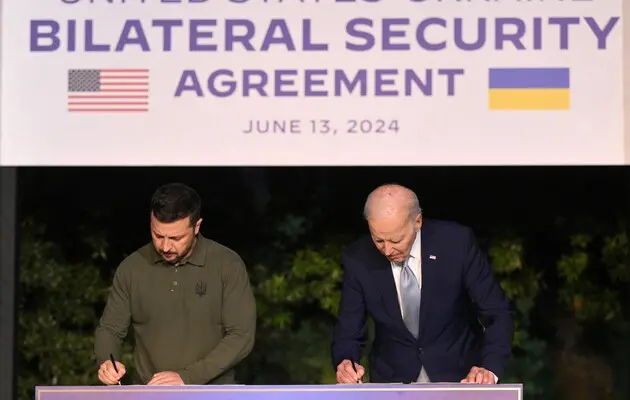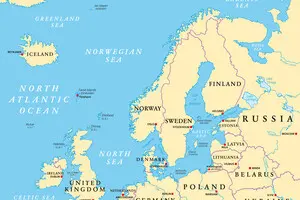Agreement between Ukraine and the United States of America: what Obligations did Washington Undertake?

After many months of negotiations between Kyiv and Washington on the sidelines of the G7 summit in Borgo Egnazia, Volodymyr Zelenskyy and Joe Biden finally signed a bilateral agreement between Ukraine and the United States of America in the field of security.
This agreement fits into the general logic of Kyiv’s actions in a situation where Ukraine has no prospect of becoming a member of the North Atlantic Treaty Organization (NATO) in the foreseeable future.
In an effort to compensate for the lack of the “umbrella” of Article 5 of the Washington Treaty, the Ukrainian government is trying to create an international legal network of long-term obligations that can guarantee military, economic and political support for Ukraine from its Western partners. These agreements do not guarantee the security of our country, but only strengthen its defense capability and increase the degree of difficulty for the aggressor during an invasion.
Let us recall that Kyiv, in addition to the document with the United States of America, has already signed agreements with 16 countries and is negotiating with another dozen and a half states that are ready to “maintain a balanced division of responsibility and burden to ensure the necessary potential for the future forces of Ukraine.”
The Ukrainian-American agreement is designed to guarantee us stable support from the United States of America for the next decade. This is also in the interests of political leaders in Washington: Americans understand perfectly well that although much will depend on the political decision of the head of the White House, nevertheless, this document will allow planning for ten years and create an implicit system of certain guarantees for Ukraine in the event of Donald Trump coming to power.
With this agreement, Washington also intends to demonstrate to Moscow that it is not going to “surrender” Ukraine, and in accordance with the implementation of the “porcupine strategy” it is ready to help our country and encourage Kyiv to carry out reforms. “By signing this document, we are sending Russia a signal of our determination. If Russian President Putin thinks that he can outlast the coalition supporting Ukraine, then he is mistaken,” said National Security Advisor to the President of the United States of America Jake Sullivan.
The key provisions of the ten-year agreement are as follows.
First, in the event of a future armed attack or threat against Ukraine, political leaders in Kyiv and Washington immediately meet (within 24 hours if possible) at the highest level “to determine appropriate next steps and additional defense needs.” In this case, the United States of America also intends to “coordinate the potential need for a rapid increase in the volume or scope of U.S. security assistance to Ukraine, including the potential provision of additional weapons systems and equipment.”
Secondly, in order to provide Ukraine with a “sustainable level of assistance,” the United States of America intends to contact the United States Congress with a request to allocate funds to support our country “in times of war and peace.”
Third, political leaders in Kyiv and Washington intend to cooperate to “support recovery efforts to strengthen Ukraine’s economic stability and resilience.”
Fourthly, the Ukrainian and American sides recognize that “this agreement serves as a link to Ukraine’s future membership in the Alliance.”
Fifth, Washington agrees to facilitate the exchange of intelligence information with Kyiv and intends to assist in developing the capacity of Ukraine's intelligence agencies, in particular in the field of counterintelligence.
Sixth, the United States of America intends to train the Ukrainian military, as well as conduct joint maneuvers. At the same time, Washington not only intends to consider the issue of training Ukrainian military personnel on the territory of the United States of America, but also plans to hold consultations on the possibility of training our soldiers in Ukraine.
Seventh, the United States of America is committed to supporting Ukraine in developing a modern, NATO-interoperable Ukrainian Defense Force. In particular, Washington undertakes to support Kyiv in the development of air defense and missile defense, joint fire capabilities (including the acquisition of ammunition, unmanned aerial vehicles (UAVs), etc.), to work on the modernization of the Ukrainian Air Force (in particular, on the purchase of squadrons of modern fighters, including F- 16), etc.
Eighth, the United States of America is committed to supporting Ukraine's ability to strengthen cybersecurity and the protection of its critical infrastructure.
Ninth, the United States of America intends to keep Russian sovereign assets in US jurisdiction frozen until Russia pays for the losses it caused to Ukraine.
Tenth, Washington and Kyiv intend to work to ensure that the cost of aggression for Russia continues to rise, in particular through sanctions and export controls.
Eleventh, the United States of America intends to support Ukraine in its pursuit of the immediate release and return of all unlawfully detained and forcibly displaced civilians, especially children.
Twelfth, both countries intend to seek to bring to justice those responsible for war crimes and other international crimes committed in or against Ukraine.
Ukraine also undertakes to carry out economic, judicial, law enforcement, and defense reforms, fight corruption, develop democracy, monitor received American weapons, work on transparency in procurement policies, reform Ukroboronprom State Concer, etc.
As stated in the document, “Washington’s security commitments contained in the agreement are aimed at supporting Kyiv’s efforts to win the current war and deter future Russian military aggression.”
However, the Ukrainian-American agreement turned out to be less ambitious than the Ukrainian-British one. The text contains a lot of intentions expressed by the United States of America regarding assistance to Ukraine. And few real commitments.
We had the right to expect more from an agreement with a country that is the leader of the democratic world. However, in an effort to make a fortress out of Ukraine, bristling with “porcupine quills,” Washington did not undertake obligations that were at least partially consistent with American promises to Tel Aviv.
For example, at the negotiation stage, Kyiv proposed that a specific amount of assistance be fixed for the duration of the document. Political leaders in Kyiv wanted it to be done approximately in the same way as was done in the Memorandum of Military Assistance to Israel for 2019–2028, according to which the Americans pledged to provide the Israelis with $38 billion over ten years. But Washington only stated in the agreement that it would appeal to the United States Congress with a request to allocate funds to Ukraine.
For Kyiv, such a situation contains risks, since it increases dependence on the domestic political situation in the United States of America: Ukraine would not want a repeat of the seven-month epic in the United States Congress, which negatively affected our ability to resist the Russian offensive. The fears are not unfounded, since, according to Reuters, Donald Trump has already criticized the $61 billion aid package to Ukraine during a closed meeting with representatives of the Republican Party at the Capitol on June 13.
Washington also turned out to be unprepared to meet Kyiv’s wishes and place military reserves on Ukrainian territory that Ukraine could use in the event of a new invasion. (The same way Tel Aviv does if necessary.)
Why, despite the geopolitical significance of Ukraine for the United States of America and the desire to support us in the armed confrontation with Russia, did the American side not take on more specific obligations to support our country? Of course, one of the reasons is Biden and his administration’s fear of an escalation of the conflict and direct confrontation between the United States of America and the Russian Federation: the specter of nuclear Armageddon is haunting the Oval Office.
However, there are other reasons: it is very important to understand that for the United States of America, although Ukraine is important on the foreign policy agenda, it is not on the electoral agenda. And the Ukrainian-American agreement on security cooperation does not add anything for Biden on the electoral field. It is possible that Washington also believes that the overly ambitious agreement may be revised (and not for the better) or even annulled by the next head of the White House.
In a situation where there is a high probability of Trump winning the presidential election, for a future Ukrainian-American security agreement, ratification by the United States Congress could indeed be a guarantee of the existence of the document. But although Volodymyr Zelenskyy said that “the agreement contains a very detailed legally binding part, and this is the reliability of America’s support for our independence,” this is not entirely true.
Later, the deputy head of the Office of the President of Ukraine, Ihor Zhovkva, explained in a comment to European Pravda that the United States of America intends to further strengthen the binding nature of the agreement through its approval in parliament. “The corresponding resolution of the United States Congress will be adopted in both chambers. This will not formally be a ratification, since an executive agreement of this type does not require ratification, but we will receive political and legal support from the United States Congress,” Zhovkva said.
But, in all honesty, it is worth admitting that there are hundreds of ways not to comply with a signed and ratified document. And in the absence of political will, there are no guarantees that the fifth article of the Washington Treaty will be applied. In particular, to protect the Baltic countries from Russian aggression.
Once a bilateral security agreement is signed, it is critical that the United States of America, regardless of administration, maintain the political will to honor the commitments Washington made in the agreement to long-term support for Ukraine in its existential standoff with Russia. After all, as recognized by both sides, strengthening the security of Ukraine is of central importance for European and American security.
Read this article in Ukrainian and russian.
Please select it with the mouse and press Ctrl+Enter or Submit a bug
















 Login with Google
Login with Google